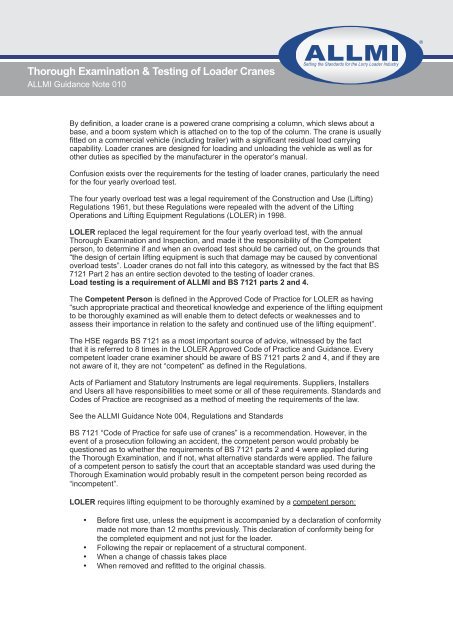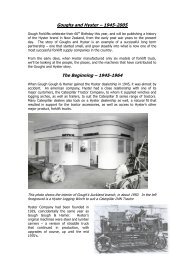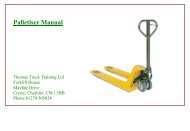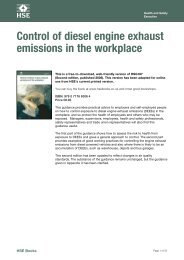Thorough Examination & Testing of Loader Cranes - Forshaw ...
Thorough Examination & Testing of Loader Cranes - Forshaw ...
Thorough Examination & Testing of Loader Cranes - Forshaw ...
Create successful ePaper yourself
Turn your PDF publications into a flip-book with our unique Google optimized e-Paper software.
®<br />
<strong>Thorough</strong> <strong>Examination</strong> & <strong>Testing</strong> <strong>of</strong> <strong>Loader</strong> <strong>Cranes</strong><br />
ALLMI Guidance Note 010<br />
By definition, a loader crane is a powered crane comprising a column, which slews about a<br />
base, and a boom system which is attached on to the top <strong>of</strong> the column. The crane is usually<br />
fitted on a commercial vehicle (including trailer) with a significant residual load carrying<br />
capability. <strong>Loader</strong> cranes are designed for loading and unloading the vehicle as well as for<br />
other duties as specified by the manufacturer in the operator’s manual.<br />
Confusion exists over the requirements for the testing <strong>of</strong> loader cranes, particularly the need<br />
for the four yearly overload test.<br />
The four yearly overload test was a legal requirement <strong>of</strong> the Construction and Use (Lifting)<br />
Regulations 1961, but these Regulations were repealed with the advent <strong>of</strong> the Lifting<br />
Operations and Lifting Equipment Regulations (LOLER) in 1998.<br />
LOLER replaced the legal requirement for the four yearly overload test, with the annual<br />
<strong>Thorough</strong> <strong>Examination</strong> and Inspection, and made it the responsibility <strong>of</strong> the Competent<br />
person, to determine if and when an overload test should be carried out, on the grounds that<br />
“the design <strong>of</strong> certain lifting equipment is such that damage may be caused by conventional<br />
overload tests”. <strong>Loader</strong> cranes do not fall into this category, as witnessed by the fact that BS<br />
7121 Part 2 has an entire section devoted to the testing <strong>of</strong> loader cranes.<br />
Load testing is a requirement <strong>of</strong> ALLMI and BS 7121 parts 2 and 4.<br />
The Competent Person is defined in the Approved Code <strong>of</strong> Practice for LOLER as having<br />
“such appropriate practical and theoretical knowledge and experience <strong>of</strong> the lifting equipment<br />
to be thoroughly examined as will enable them to detect defects or weaknesses and to<br />
assess their importance in relation to the safety and continued use <strong>of</strong> the lifting equipment”.<br />
The HSE regards BS 7121 as a most important source <strong>of</strong> advice, witnessed by the fact<br />
that it is referred to 8 times in the LOLER Approved Code <strong>of</strong> Practice and Guidance. Every<br />
competent loader crane examiner should be aware <strong>of</strong> BS 7121 parts 2 and 4, and if they are<br />
not aware <strong>of</strong> it, they are not “competent” as defined in the Regulations.<br />
Acts <strong>of</strong> Parliament and Statutory Instruments are legal requirements. Suppliers, Installers<br />
and Users all have responsibilities to meet some or all <strong>of</strong> these requirements. Standards and<br />
Codes <strong>of</strong> Practice are recognised as a method <strong>of</strong> meeting the requirements <strong>of</strong> the law.<br />
See the ALLMI Guidance Note 004, Regulations and Standards<br />
BS 7121 “Code <strong>of</strong> Practice for safe use <strong>of</strong> cranes” is a recommendation. However, in the<br />
event <strong>of</strong> a prosecution following an accident, the competent person would probably be<br />
questioned as to whether the requirements <strong>of</strong> BS 7121 parts 2 and 4 were applied during<br />
the <strong>Thorough</strong> <strong>Examination</strong>, and if not, what alternative standards were applied. The failure<br />
<strong>of</strong> a competent person to satisfy the court that an acceptable standard was used during the<br />
<strong>Thorough</strong> <strong>Examination</strong> would probably result in the competent person being recorded as<br />
“incompetent”.<br />
LOLER requires lifting equipment to be thoroughly examined by a competent person:<br />
• Before first use, unless the equipment is accompanied by a declaration <strong>of</strong> conformity<br />
made not more than 12 months previously. This declaration <strong>of</strong> conformity being for<br />
the completed equipment and not just for the loader.<br />
• Following the repair or replacement <strong>of</strong> a structural component.<br />
• When a change <strong>of</strong> chassis takes place<br />
• When removed and refitted to the original chassis.
Periodic thorough examinations are also required:<br />
• In the case <strong>of</strong> lifting equipment for lifting persons, or a lifting accessory (e.g. slings,<br />
chains, grabs, buckets etc) at least every 6 months;<br />
• In the case <strong>of</strong> other lifting equipment, at least every 12 months<br />
BS 7121 Part 2 – Recommendations for periodic testing and thorough examination <strong>of</strong> loader<br />
cranes.<br />
Occasion<br />
Before being first taken into service<br />
Annually after being first put into service<br />
Minimum test and thorough examination<br />
Full test<br />
Pro<strong>of</strong> load test <strong>of</strong> rated capacity +10% at full<br />
radius and through the full slewing arc, and a<br />
thorough examination<br />
4 years after first being put into service Full test<br />
8 years after first being put into service Non-destructive test <strong>of</strong> structure<br />
Full test<br />
After each structural repair or component change<br />
When chassis is changed<br />
Is removed and refitted<br />
Full test<br />
Full test<br />
Full test<br />
ALLMI totally endorses the recommendations <strong>of</strong> BS 7121 part 2, to be incorporated in the<br />
Annual <strong>Thorough</strong> <strong>Examination</strong> and inspection required by LOLER.<br />
Reference information.<br />
BS EN 12999 <strong>Cranes</strong> – <strong>Loader</strong> <strong>Cranes</strong><br />
LOLER Lifting Operations and Lifting Equipment Regulations<br />
PUWER The Provision and Use <strong>of</strong> Work Equipment Regulations<br />
ALLMI Code <strong>of</strong> Practice for Installation Application and Operation<br />
BS 7121 Safe use <strong>of</strong> cranes, Parts 2 and 4.<br />
Disclaimer<br />
This note is for guidance only, it should be studied and the information applied with the assistance <strong>of</strong> expert advice<br />
as necessary. Every effort has been made to ensure the accuracy <strong>of</strong> the information provided, but no legal liability<br />
can be accepted by ALLMI for any errors or omissions, nor for any consequences there<strong>of</strong>.






